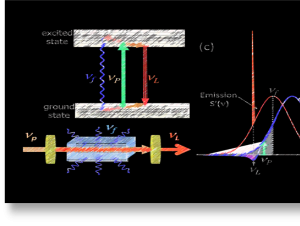
Multidisciplinary Approaches to Radiation Balanced Lasers (MARBLe)
AFOSR MURI project
Program managers :
John Luginsland, Jason Marshall, William Roach, Gernot Pomrenke
The research teams participating in the MARBLE project will address critical issues of radiation-balanced lasers (RBL) in rare-earth doped solids (crystals, glasses, fibers) and in semiconductor disc lasers. The proposed tasks aim at advancing RBL technology at a fundamental level while being responsive to the needs of the USAF (Directed Energy) and other DoD missions for high-power lasers with high beam quality. Our proposed activities span novel synthesis of cooling-grade materials, microscopic and macroscopic modeling of materials and optical heat-engines, unique characterization capabilities, and innovative implementation schemes. This MURI will advance the RBL field to new frontiers and greatly benefit the science of optical refrigeration and all-solid-state cryocoolers. Our team of investigators will leverage their well-recognized and unique experience in optical refrigeration research, material synthesis and characterization, laser physics and theoretical modeling to identify promising yet realistic areas of fundamental research in RBL and provide innovative solutions to achieve their goals. The MARBLE investigators will focus their efforts on two principal topics: (a) Advancement of RBLs in rare-earth doped systems using new hosts and new dopants; and (b) Research on semiconductor RBLs with emphasis on disc-lasers. In part (a), our proposed activities include investigation of RBL in fiber lasers, novel material synthesis, 2-tone RBLs involving single ion and two-ion systems, mid-IR RBLs, and thermal gradient mitigation in high-power scaling. For part (b), we will study the feasibility of RBL operation in both II-VI and III-V compounds. On the material side, we seek novel approaches to synthesize and characterize cooling grade II-VI structures (e.g. CdS and CdTe thin films). In parallel, in collaboration with leading material scientists in industry (Crystal Mirrors) and national labs (MITLL) and exploiting both MOCVD and phosphorous MBE growth techniques, we will investigate optical refrigeration and RBL operation in such materials. When successful, the demonstration of cooling and RBL in semiconductors will mark an exciting and remarkable era in laser physics and thermal photonics.
The ability to demonstrate high-power lasers without net internal heat generation will have immense payoffs in several key DoD mission applications such as directed energy, remote detection, and sensing. The proposed work will give enhanced understanding of the heat-dissipation limits of RE-doped fiber and disk-lasers as well as semiconductor disk lasers for applications requiring >1 kW average power and high beam quality. The material synthesis work of this effort will have broad-ranging, general implications for high-power lasers as well as optical refrigeration, two topics with significant DoD applications. The proposed work on semiconductor-disk RBL lasers, if successful, will represent a significant breakthrough in the field of laser science and solid-state optical refrigeration.
